Study of Supercritical State Characteristics of Miscible CO2 Used in the Flooding Process
Abstract
:1. Introduction
2. Experimental Equipment and Methods
2.1. Experimental Equipment
2.2. Experimental Materials
2.3. Experimental Procedures
2.3.1. Phase Behavior of Supercritical CO2
2.3.2. Phase Behavior of Supercritical CO2—Formation Oil System
3. CO2 Supercritical Phase Behavior
3.1. Phase Behavior of CO2 at Saturation Vapor Pressure Line
3.2. Phase Behavior of CO2 from Gas Phase to Supercritical Phase
3.3. Phase Behavior of CO2 from Liquid Phase to Supercritical Phase
4. Supercritical Phase Behavior of CO2-Formation Oil System
4.1. Phase Behavior of Supercritical Injection Gas-Formation Oil System during Mass Transfer Process
4.2. Difference of Components in Supercritical Phase Region during Mass Transfer Process
4.3. Mass Transfer Capacity of Supercritical CO2 Extraction
5. Supercritical CO2 and Miscible-Phase Matching Mechanism
6. Conclusions
- (1)
- During the development process, the phase behavior of supercritical CO2 is complex. Experimental research shows that CO2 is a continuous change process when transitioning from a gas (or liquid) phase to a critical phase. When the pressure in the supercritical phase region increases, the number of droplet molecules increases, the density of CO2 changes drastically and the dissolving capacity and extraction capacity are significantly improved.
- (2)
- Supercritical CO2 has a significantly higher extraction capacity for formation oil components compared to supercritical CH4 and N2. The extraction and mass transfer capacity of CO2 is the most affected by the pressure, followed by CH4 and N2. The understanding of the phase behavior of CO2 provided the theoretical guidance for the application of CO2 flooding on the oilfields.
- (3)
- The density of supercritical CO2 is closely related to the oil–gas miscibility. The minimum miscible pressure of low-permeability reservoirs lies in the density range of supercritical CO2 of 0.50–0.85 g/cm3 in China and 0.40–0.80 g/cm3 abroad. The density of supercritical CO2 when CO2-formation oil reaches miscibility is mainly affected by temperature and oil composition, which provides a deeper view to understand the inner relationship between the supercritical CO2 and the oil–gas miscibility.
Author Contributions
Funding
Data Availability Statement
Conflicts of Interest
References
- Xiang, Y.; Hou, L.; Du, M.; Jia, N.-H.; Lyu, W.-F. Research progress and development prospect of CCUS-EOR technologies in China. Pet. Geol. Recovery Effic. 2023, 30, 1–17. [Google Scholar]
- Gambelli, A.-M. CCUS Strategies as Most Viable Option for Global Warming Mitigation. Energies 2023, 16, 4077. [Google Scholar] [CrossRef]
- Zhao, Z.-Y.; Yao, S.; Yang, S.-P.; Wang, X.-L. Under Goals of Carbon Peaking and Carbon Neutrality: Status, Problems, and Suggestions of CCUS in China. Environ. Sci. 2023, 44, 1128–1138. [Google Scholar]
- Peng, X.-T.; Lyu, H.-D.; Zhang, X. Interpretation of IPCC AR6 report on carbon capture, utilization and storage (CCUS) technology development. Clim. Chang. Res. 2022, 18, 580–590. [Google Scholar]
- Zhao, Y.; Itakura, K.-I. A State-of-the-Art Review on Technology for Carbon Utilization and Storage. Energies 2023, 16, 3992. [Google Scholar] [CrossRef]
- Li, Y. Technical advancement and prospect for CO2 flooding enhanced oil recovery in low permeability reservoirs. Pet. Geol. Recovery Effic. 2020, 27, 1–10. [Google Scholar]
- Shen, P.-P.; Liao, X.-W. The Technology of Carbon Dioxide Stored in Geological Media and Enhanced Oil Recovery; Petroleum Industry Press: Beijing, China, 2009. [Google Scholar]
- Yuan, S.-Y.; Ma, D.-S.; Li, J.-S.; Zhou, T.-Y.; Ji, Z.-M.; Han, H.-S. Progress and prospects of carbon dioxide capture, EOR-utilization and storage industrialization. Pet. Explor. Dev. 2022, 49, 828–834. [Google Scholar] [CrossRef]
- Zhang, X.; Li, Y.; Ma, Q.; Liu, L.-N. Development of Carbon Capture, Utilization and Storage Technology in China. Strateg. Study CAE 2021, 23, 70–80. [Google Scholar] [CrossRef]
- Dou, L.-R.; Sun, L.-D.; Lyu, W.-F.; Wang, M.-Y.; Gao, F.; Gao, M.; Jiang, H. Trend of global carbon dioxide capture, utilization and storage industry and challenges and countermeasures in China. Pet. Explor. Dev. 2023, 50, 1–14. [Google Scholar]
- He, D.-B.; Jia, C.-Y.; Wei, Y.-S.; Guo, J.-L.; Ji, G.; Li, Y.-L. Current situation and development trend of world natural gas industry. Nat. Gas Ind. 2022, 42, 1–12. [Google Scholar]
- Liao, G.-Z.; He, D.-B.; Wang, G.-F.; Wang, L.-G.; Wang, Z.-M.; Su, C.-M.; Qin, Q.; Bai, J.-H.; Hu, Z.-Q.; Huang, Z.-J.; et al. Discussion on the limit recovery factor of carbon dioxide flooding in a permanent sequestration scenario. Pet. Explor. Dev. 2022, 49, 1463–1470. [Google Scholar] [CrossRef]
- Liao, G.-Z.; Wang, L.-G.; Wang, Z.-M. Practice and Reflection of Important Development Experiments. Pet. Sci. Technol. Forum 2019, 38, 1–10. [Google Scholar]
- Zhu, X. Jilin Oilfield to Build CCUS-EOR Technology Incubation Base. Unconv. Oil Gas 2022, 9, 118. [Google Scholar]
- Liu, Z.-Q. Exploration of New Path of Global Carbon Emission Reduction. China Petroleum Daily, 11 May 2019. [Google Scholar]
- Lei, Y.-J. The China Carbon Dioxide Capture, Utilization and Storage (CCUS) Annual Report (2021) was released, suggesting the development of large-scale CCUS demonstration and industrial cluster construction. Environ. Econ. 2021, 16, 40–42. [Google Scholar]
- Zhang, Z.-B.; Chen, X.; Qian, Y.-C.; Liu, Q.; Lyu, W.-F.; Luo, M.-L.; Fan, X.-L. Experimental study of CO2 storage in water-flooded oilfields. Pet. Res. 2017, 2, 378–382. [Google Scholar]
- Shang, B.-B.; Liao, X.-W.; Li, J.-F.; Lu, N.; Su, X.-K. Influence of N2 and CH4 on CO2 immiscible flooding effect. J. Shaanxi Univ. Sci. Technol. 2013, 31, 106–110. [Google Scholar]
- Li, L.; Zheng, Z.-G.; Yang, C.-W.; Chen, Z.; Zhang, W.-X.; Xu, B.-C. Experimental Study on the Displacement Characteristics and Capacity of Supercritical CO2 Flooding in Ultra Low Permeability Reservoirs. Sci. Technol. Eng. 2021, 21, 12551–12558. [Google Scholar]
- Dai, X.; Ma, Y.; Zhang, L.; Xu, Z.; Sun, X.; Zhao, S. Optimization of Molecular Composition Distribution of Slurry Oil by Supercritical Fluid Extraction to Improve the Structure and Performance of Mesophase Pitch. Energies 2022, 15, 7041. [Google Scholar] [CrossRef]
- Lian, L.-M.; Qin, J.-S.; Yang, S.-Y. Research progress and development directions of mathematical models in CO2 flooding. Pet. Geol. Recovery Effic. 2013, 20, 77–82. [Google Scholar]
- Cao, X.-P.; Feng, Q.-H.; Yang, Y.; Wang, S.; Kang, Y.-Y.; Zhang, C.-B. Migration law of CO2-crude oil miscible zone and its influence on development effect. Pet. Geol. Recovery Effic. 2021, 28, 137–143. [Google Scholar]
- Liu, J.; Li, M.; Liu, Y.; Zhao, H. Visualization experiment on micro mechanism of CO2 huff and puff. Fault-Block Oil Gas Field 2017, 24, 230–232. [Google Scholar]
- Su, C.; Sun, L.; Li, S.-L. Mechanism of CO2 Miscible Flooding During Multiple Contact Procedures. J. Southwest Pet. Univ. 2001, 23, 33–36. [Google Scholar]
- Guo, P.; Sun, L.-T.; Li, S.-L.; Xiong, Y.; Sun, L.; Peng, P.-S.; Yue, L. Theoretical Simulation and Experimental Study of The Influence of CO2 Injection on PVT of Crude Oil. Nat. Gas Ind. 2000, 2, 76–79. [Google Scholar]
- Belhaj, H.; Abukhalifeh, H.; Javid, K. Miscible oil recovery utilizing N2 and/or HC gases in CO2 injection. J. Pet. Sci. Eng. 2013, 111, 144–152. [Google Scholar] [CrossRef]
- Hu, Z.-H.; Song, W.-Z.; Yang, Y. Experimental study of the influence of natural gas injection on PVT of crude oil. Petrochem. Ind. Appl. 2014, 33, 36–39. [Google Scholar]
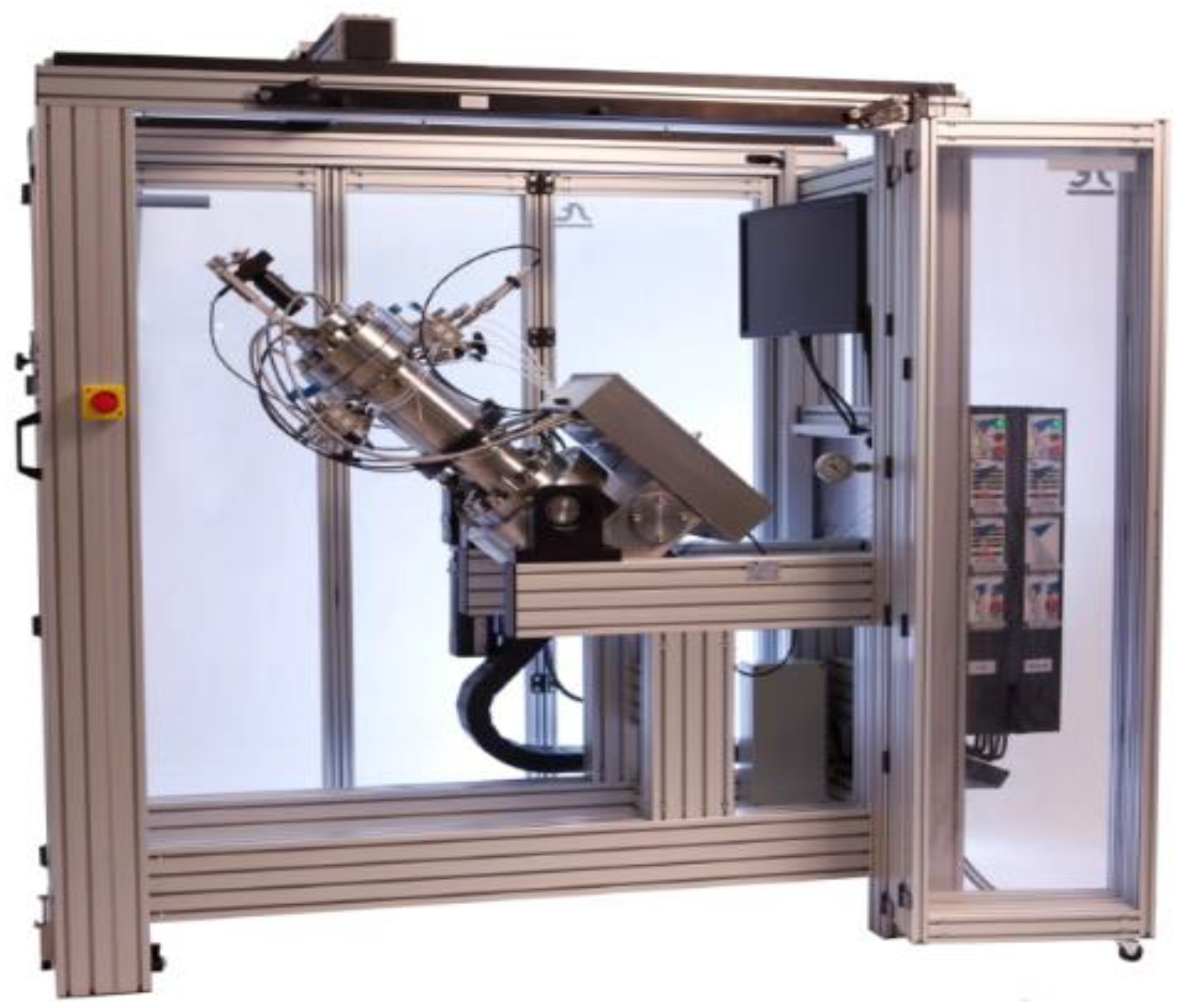
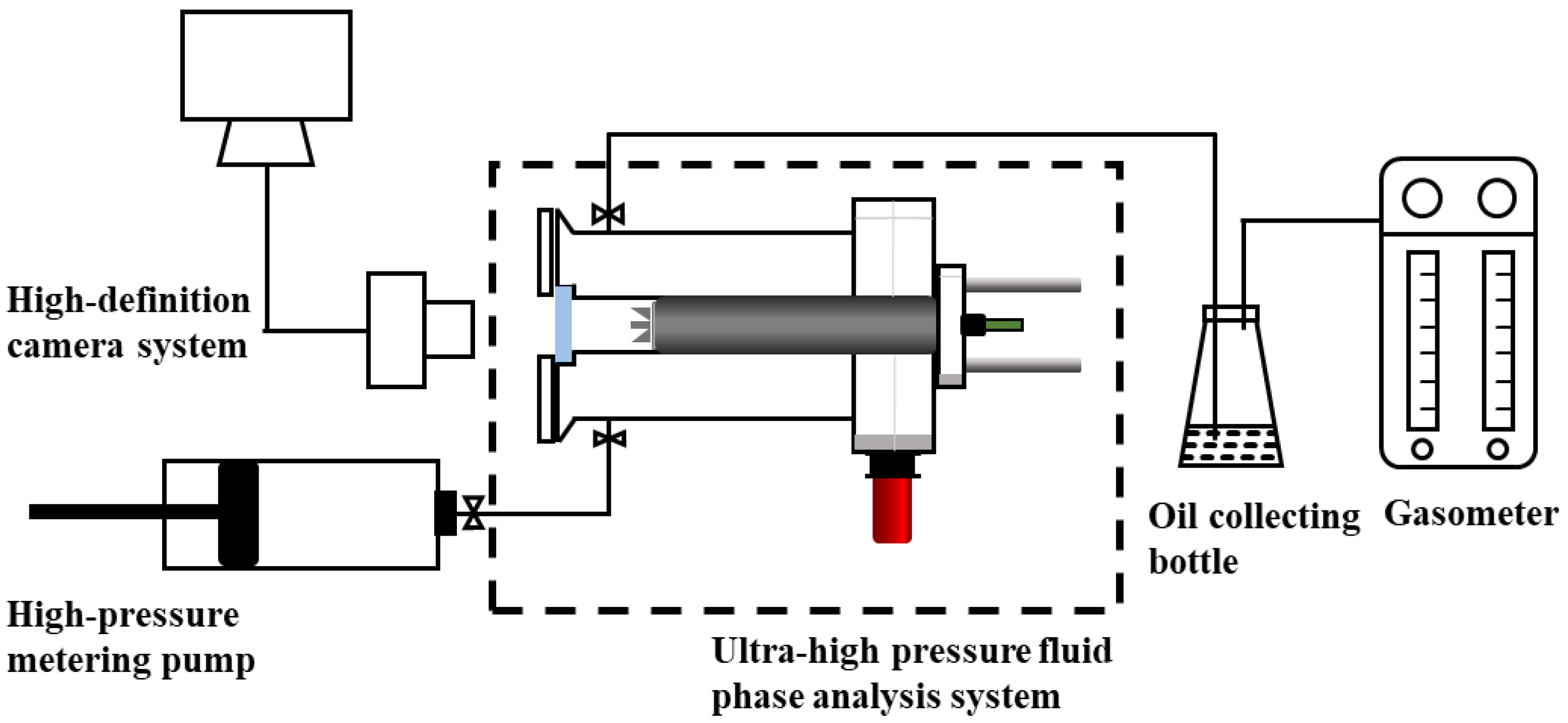
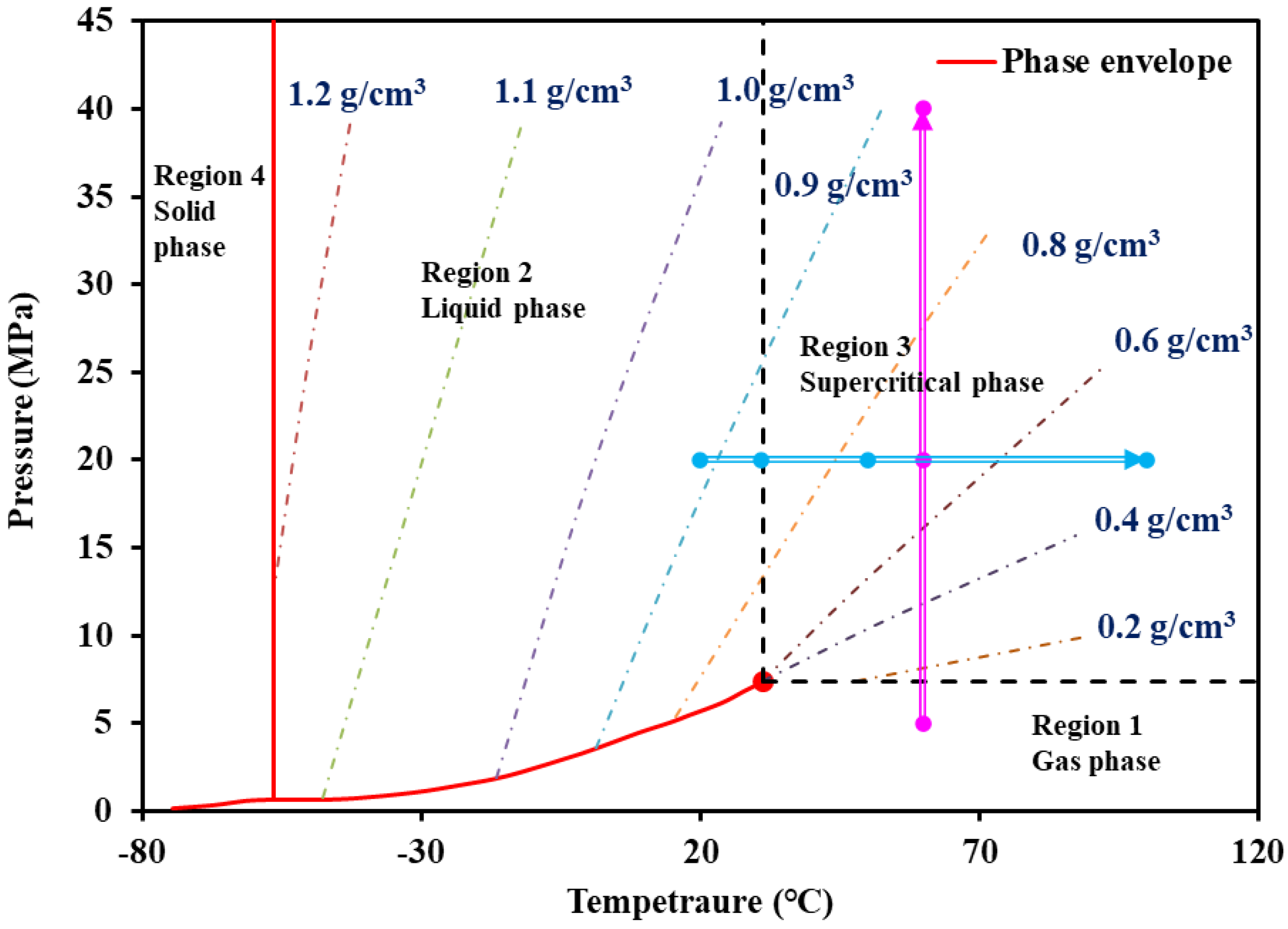

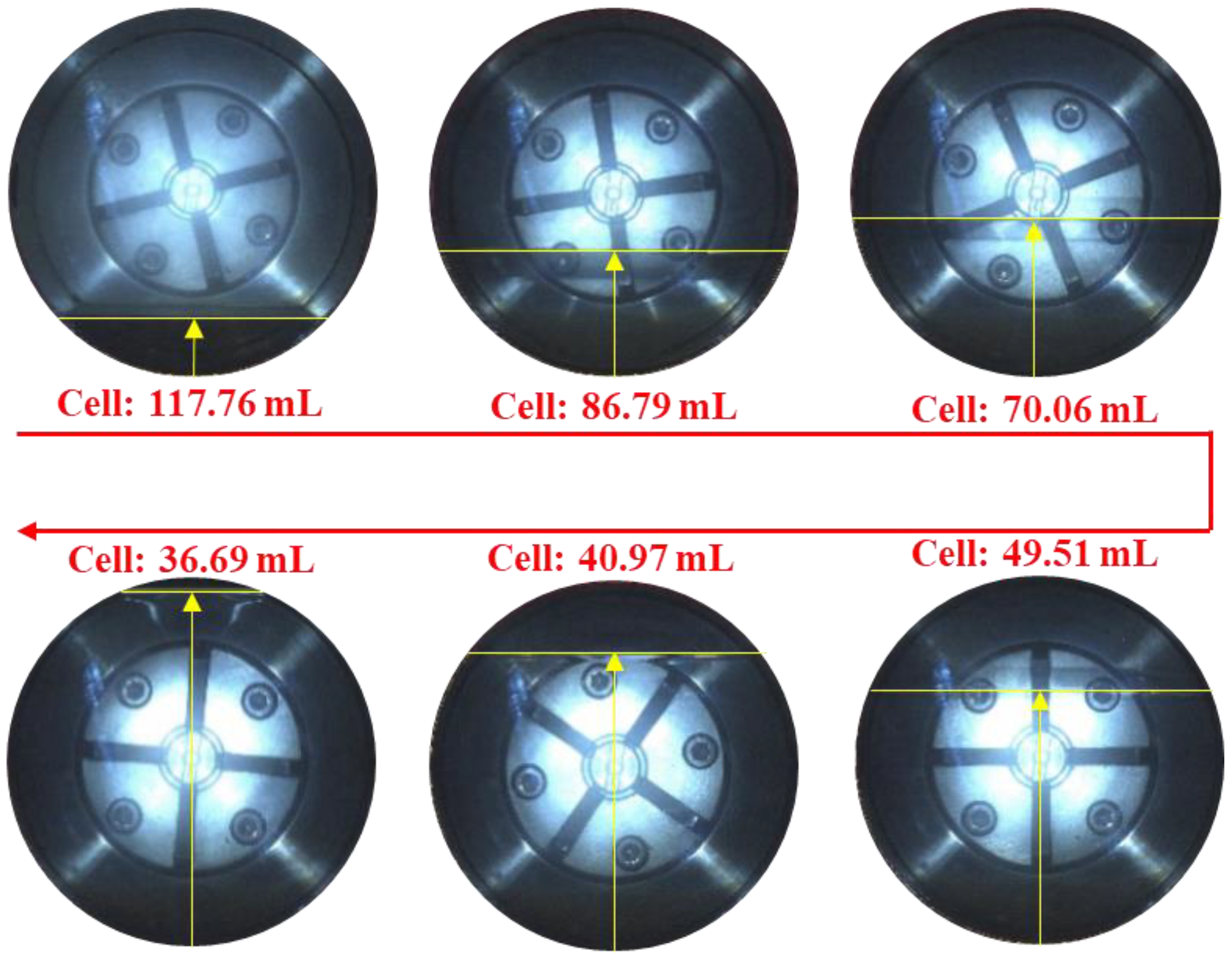
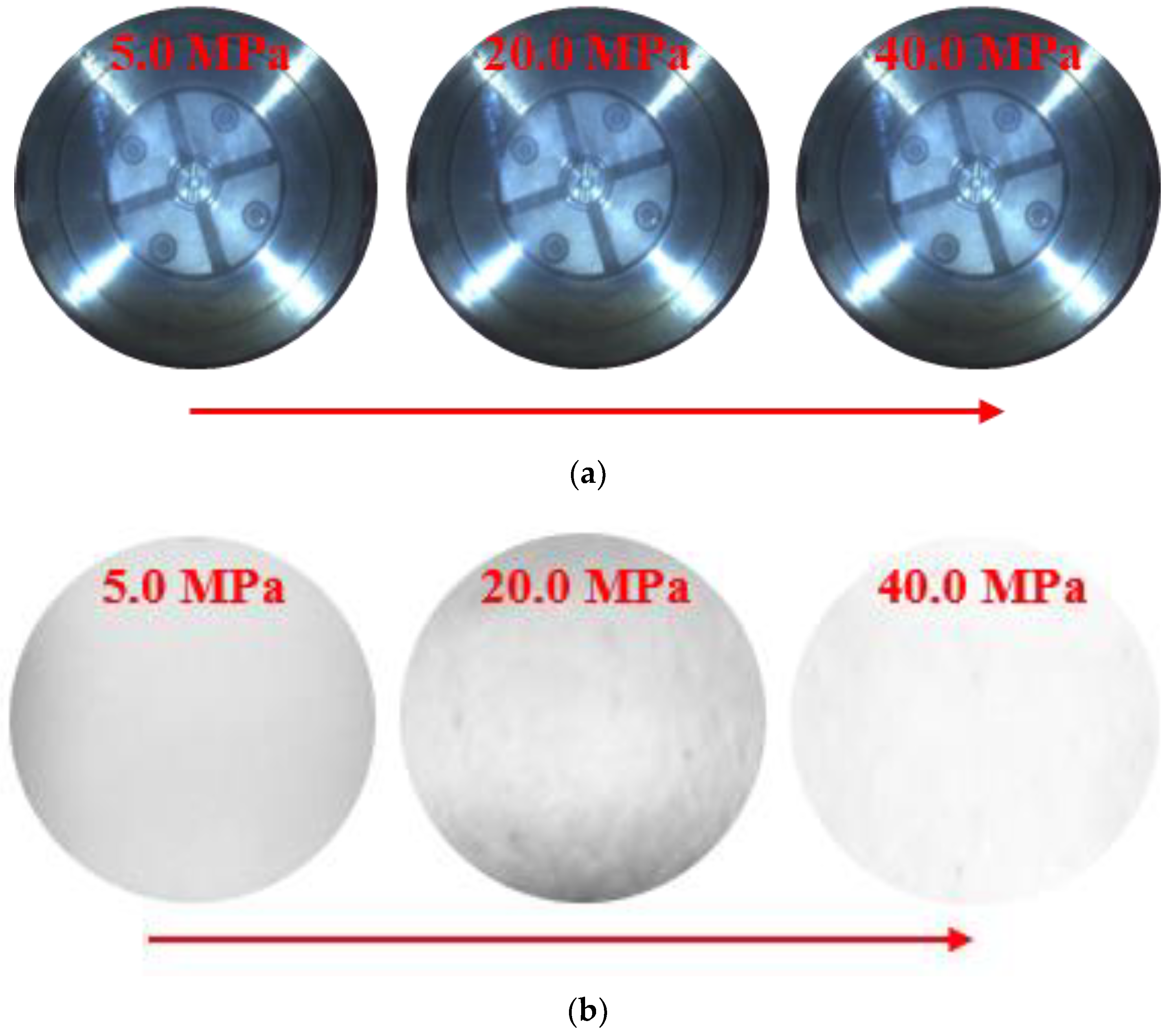

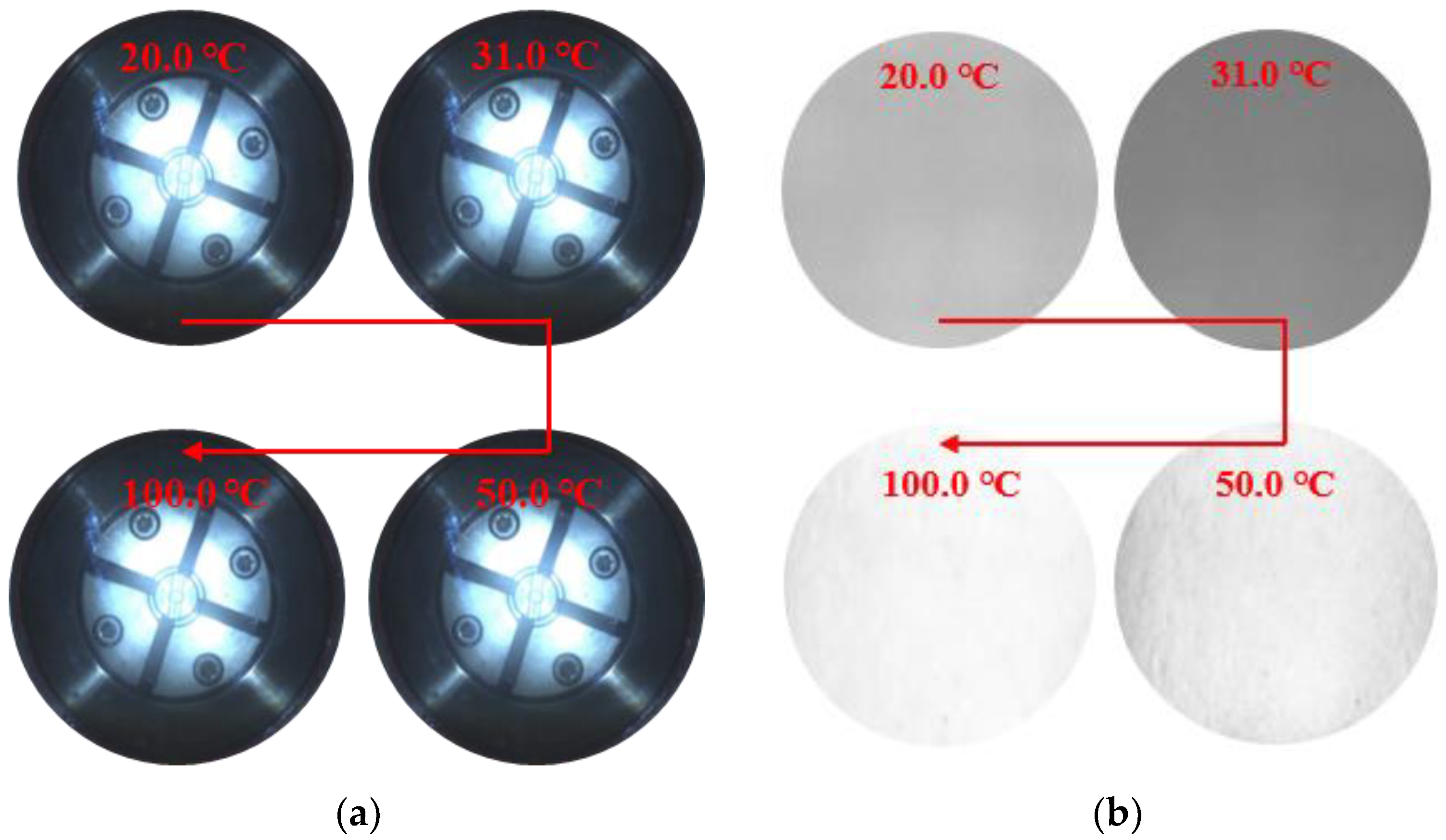
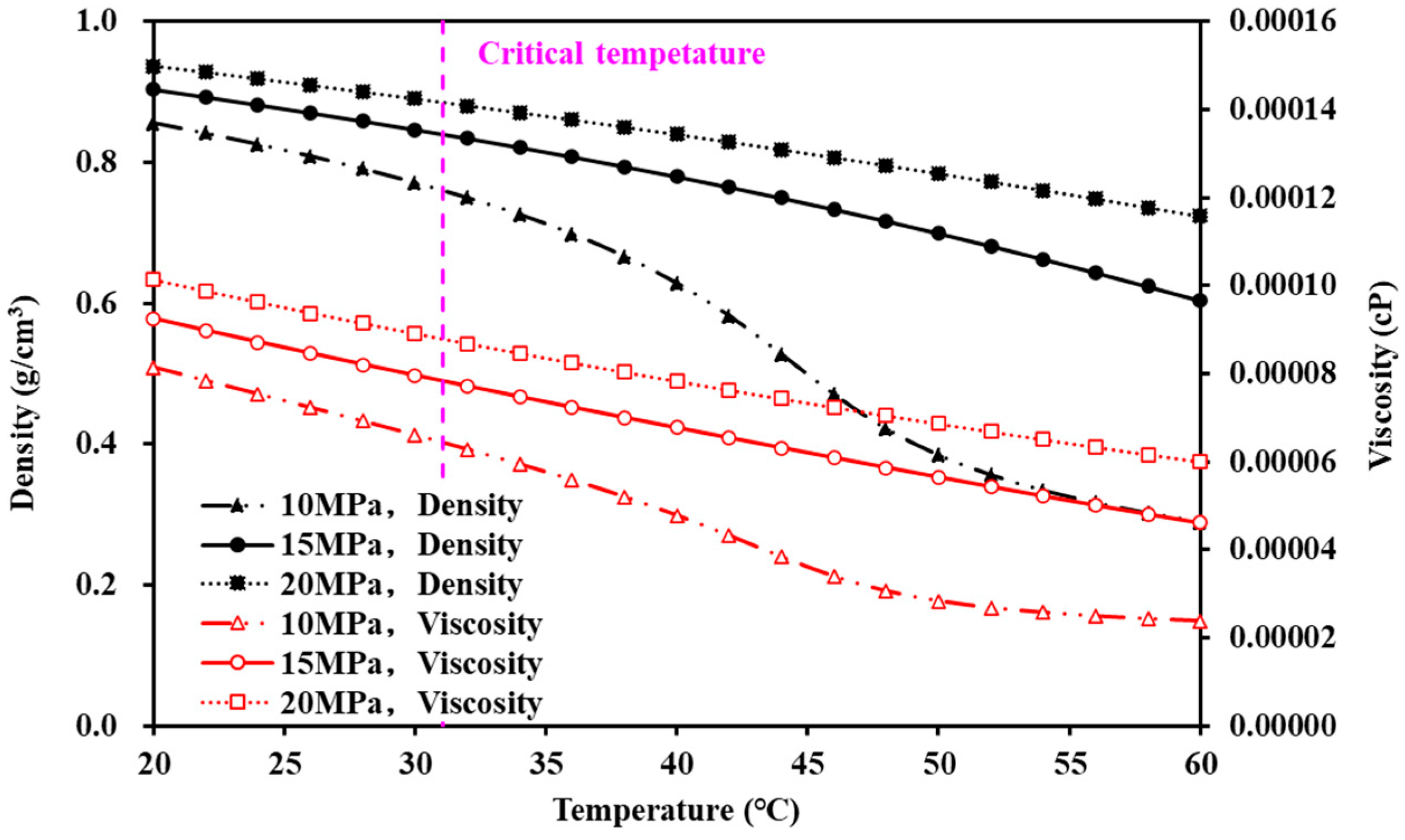




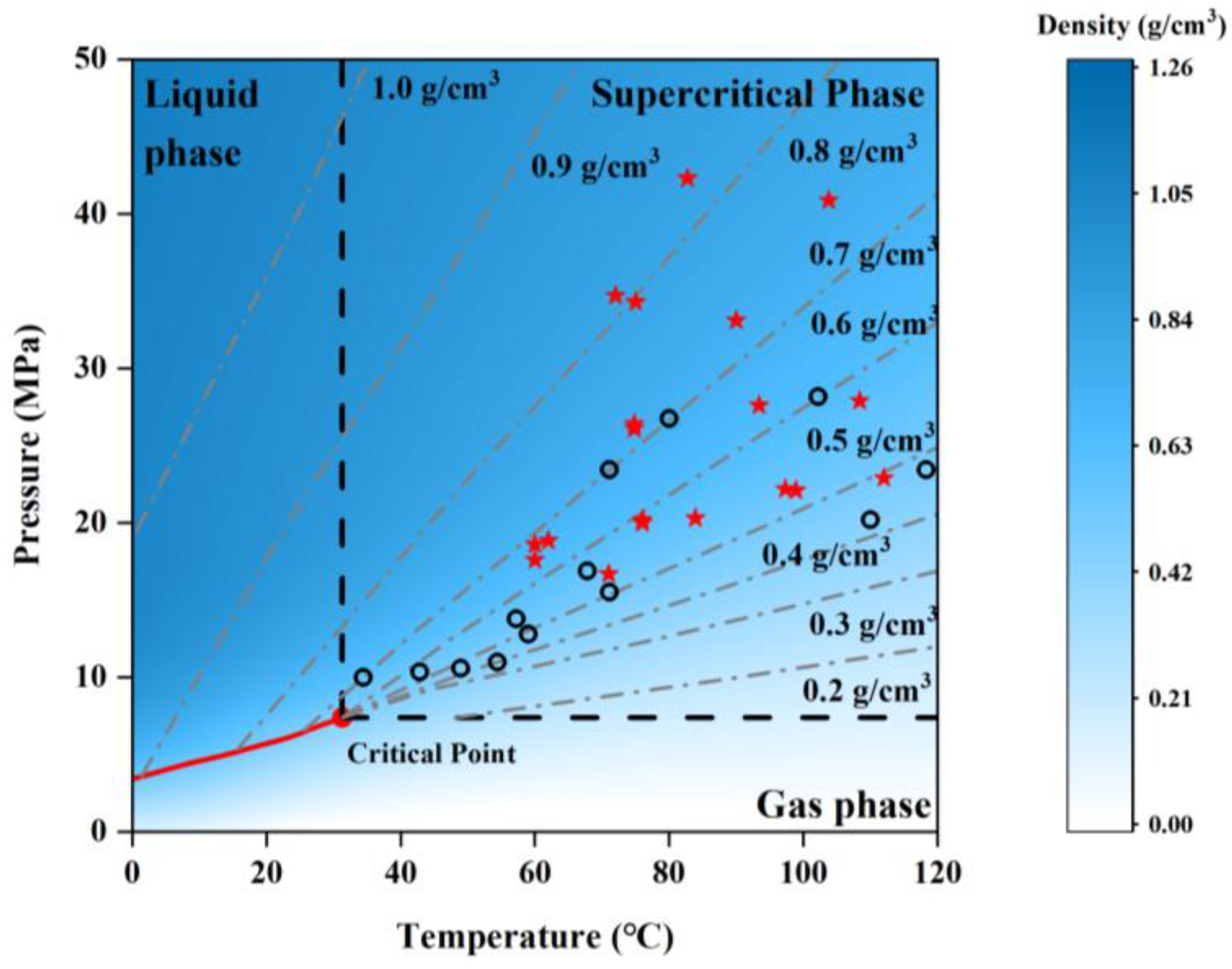
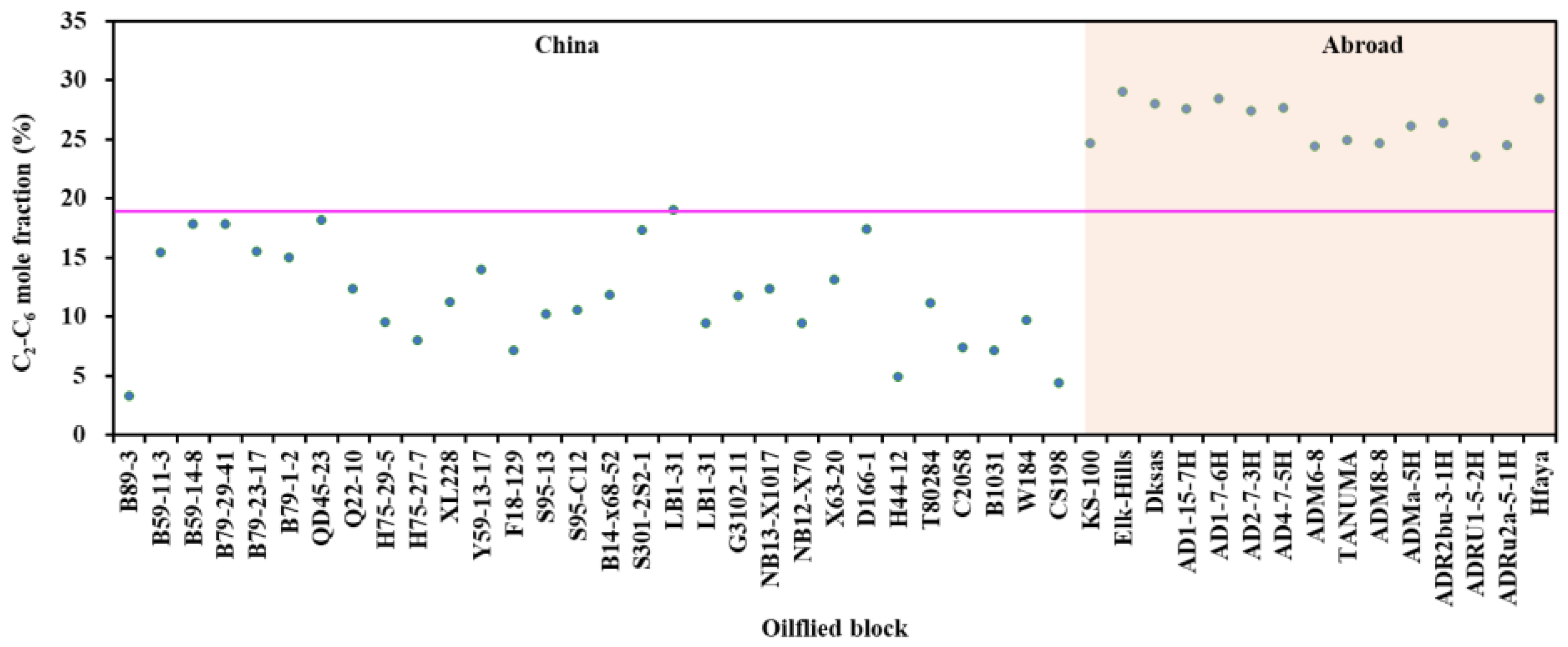

Disclaimer/Publisher’s Note: The statements, opinions and data contained in all publications are solely those of the individual author(s) and contributor(s) and not of MDPI and/or the editor(s). MDPI and/or the editor(s) disclaim responsibility for any injury to people or property resulting from any ideas, methods, instructions or products referred to in the content. |
© 2023 by the authors. Licensee MDPI, Basel, Switzerland. This article is an open access article distributed under the terms and conditions of the Creative Commons Attribution (CC BY) license (https://creativecommons.org/licenses/by/4.0/).
Share and Cite
Zhang, Y.; Lyu, W.; Zhang, K.; He, D.; Li, A.; Cheng, Y.; Gao, J. Study of Supercritical State Characteristics of Miscible CO2 Used in the Flooding Process. Energies 2023, 16, 6693. https://doi.org/10.3390/en16186693
Zhang Y, Lyu W, Zhang K, He D, Li A, Cheng Y, Gao J. Study of Supercritical State Characteristics of Miscible CO2 Used in the Flooding Process. Energies. 2023; 16(18):6693. https://doi.org/10.3390/en16186693
Chicago/Turabian StyleZhang, Yu, Weifeng Lyu, Ke Zhang, Dongbo He, Ao Li, Yaoze Cheng, and Jiahao Gao. 2023. "Study of Supercritical State Characteristics of Miscible CO2 Used in the Flooding Process" Energies 16, no. 18: 6693. https://doi.org/10.3390/en16186693




